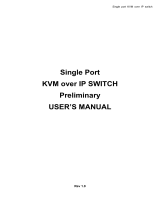
19
To create/edit computer names
1 Display the KVM conguration menu. Note: You must be logged-in as the
ADMIN user.
2 Use to highlight ‘Edit Computer List’ and press .
3 Either:
• Create a new computer entry – Press and enter a new name, or
• Edit an existing computer entry – Use and to highlight a computer
name and press . Press (Backspace) to delete existing characters
and enter the required new name (up to 16 characters).
4 Press and the cursor will move to the computer port column on the right
side. Change or enter the port address of the computer as required. See
the Addressing computers in a cascade section for more details. When
the port address is complete, press . The ‘Edit access rights’ menu will be
displayed. Here you can determine which users should have access to the
created/edited computer. Only users that show a ‘+’ marker to the right of
the menu box will be granted access to the computer.
Note: Access rights for particular user accounts to computers can also be
controlled from the ‘Edit User List’ menu
5 Select and deselect users as follows:
• Individual user - Use and to highlight a user name, then press
to apply, or remove, the ‘+’ marker.
• Allow access for all users – Press
• Allow no user access (except ADMIN) – Press
6 When all settings have been made, press to save and exit. Press to
return to the ‘Conguration Menu’.
Tips when creating/editing computer names
• Avoid creating two names for the same computer port.
• When cascading to other SmartView devices, do not apply individual names
to any ports that are forming a link group to another switch (i.e. ports 1, 2,
3 and 4 when they form link group 41).
Autoscanning
The SmartView World provides an autoscan mode that switches between
the connected computers in sequence. This mode is useful to allow users
and administrators to sample activity among the connected machines. Three
scanning modes are provided:
• Scan list – Only computers declared within an autoscan list will be viewed.
Computers connected to cascaded switches can be included in the autoscan
list.
• Active PCs – Only computer ports where an active computer is detected will
be viewed. This mode avoids blank screens from being displayed and helps
to prevent the viewing monitor from entering a power-down state on every
scan cycle. Computers connected to cascaded switches will not be viewed in
this mode.
• All PCs – This mode visits, in turn, each computer that is connected directly
to the SmartView World. This mode should be used with care due to the
reasons given in the warning below. Computers connected to cascaded
switches will not be viewed in this mode.
The scanning mode is a global setting and hence will be the one viewed by any
user who selects on their keyboard. Note, however, that users will
only see the scanned computers to which they have access rights. Hence, if four
users (with various access rights) simultaneously view an autoscan, they will see
differing results depending upon their respective permissions.
WARNING: Many modern monitors are tted with automatic power
saving relays that switch off after a few seconds when connected to
an inactive computer. If you are using such a monitor, do not set the
SmartView World to the scan ‘ALL PCs’ mode. Continual switching on and
off of the monitor’s relay will eventually damage the monitor. If using
such a monitor in conjunction with the ‘Scan List’ option, ensure that all
selected computers are active.
There are up to three steps that need to be congured to use autoscanning:
• Select the autoscan mode: List, Active or All.
• Select the autoscan period. This is the time that is spent viewing each
computer. This step also enables and disables the autoscan feature.
• Dene the autoscan list. This step is only required when the Scan List option
is selected and allows you to select which computers will be scanned.





















